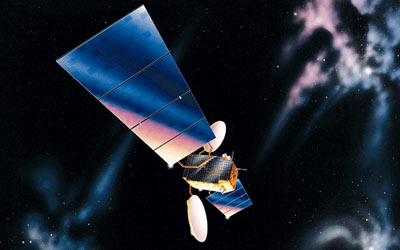A satellite bouquet for Karen Hughesby Taylor Dinerman
|
| In fact, if it was not for the demand for DBS spacecraft, the US civil space industry might simply go out of business. |
A modern DBS satellite such as EchoStar 7, based on a Lockheed Martin A2100 bus, can handle more than 500 channels of video, data, or radio programming. The US government’s full bouquet of services might fill up a third or less that capability. For the purposes of public diplomacy Voice of America TV probably does not use more than a dozen channels on any one DBS satellite, if that. They do lease transponders on at least six different satellites, such as Eutelsat’s Hot Bird 3 and Asiasat 2, to give them worldwide coverage.
A middle-class family in, say, Tunisia, with a satellite dish and a slightly above average level of curiosity, will probably be able to tune into a single US government satellite TV channel which, no matter how interesting or well produced, will still be easily identified as US government propaganda and will thus be discounted, as all government-produced TV is in the developing world. People in these countries are highly distrustful of all outsiders and outside sources of information, and in most cases rightly so.
Karen Hughes has gone to work in the State Department with the job of improving America’s public diplomacy. If this is not a real-life “Mission Impossible”, it is close to one. In what Francis Fukuyama called “Low Trust Societies”, breaking through the thick crust of suspicion is incredibly difficult. Normally in these societies when the government or a political movement wants to make an impression, they have to hammer it home with the most violent and aggressive message possible.
The US has, so far, not been able to take full advantage of the advanced DBS satellite capabilities. If it did, it might be able to broadcast a new kind of public information into the Middle East: an Arab C-SPAN or several similar channels. After all, neither the US nor any western TV station can compete with Aljazeera or Hezbollah TV in terms of emotional impact, so why not go to the other extreme?
C-SPAN may sometimes be as exciting as watching the grass grow, but it has become an essential part of our democracy, allowing ordinary Americans to watch the Congress and the political class in action. It has become another way for citizens to keep an eye on the politicians, who, after all, need all the watching they can get. According to reports, Iraqis have been fascinated when they get the chance to see their new government trying to get itself up and running. Like Americans, they certainly know that there is a lot going on that they cannot see, but what they do see is enough to demystify their new leaders and that in itself is an accomplishment.
| C-SPAN may sometimes be as exciting as watching the grass grow, but it has become an essential part of our democracy, allowing ordinary Americans to watch the Congress and the political class in action. |
Using DBS satellites this principle could be extended all over the Middle East. Just as during the Cold War, when the US-sponsored Radio Free Europe and Radio Liberty as substitutes for the independent local broadcasters that the peoples of Central and Eastern Europe did not have, a new set of C-SPAN-like channels, one for each nation, could substitute for the access that the peoples of these states now lack.
Getting programming and cameras into the right places to provide content will be difficult, but if the alternative is to show hours on end of dissident organizational meetings in London or elsewhere, governments in the area might be persuadable. Coverage of demonstrations might also be useful. A few years ago C-SPAN showed four or five hours of a Hamas demonstration somewhere on the West Bank. The excruciating tedium of the event showed that terror groups can be thoroughly boring.
The technology is available at bargain rates. If it wanted to the US government could build and launch their own satellite; alternatively, they could lease channels on existing spacecraft. Why should the US limit itself to one or two channels when it could deliver dozens? Political violence may be exciting on TV, but people who are sick of war might prefer to be bored.
